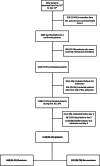The evolution of the ventilatory ratio is a prognostic factor in mechanically ventilated COVID-19 ARDS patients
- PMID: 34517881
- PMCID: PMC8436582
- DOI: 10.1186/s13054-021-03727-x
The evolution of the ventilatory ratio is a prognostic factor in mechanically ventilated COVID-19 ARDS patients
Erratum in
-
Correction to: The evolution of the ventilatory ratio is a prognostic factor in mechanically ventilated COVID-19 ARDS patients.Crit Care. 2021 Dec 17;25(1):435. doi: 10.1186/s13054-021-03849-2. Crit Care. 2021. PMID: 34920738 Free PMC article. No abstract available.
Abstract
Background: Mortality due to COVID-19 is high, especially in patients requiring mechanical ventilation. The purpose of the study is to investigate associations between mortality and variables measured during the first three days of mechanical ventilation in patients with COVID-19 intubated at ICU admission.
Methods: Multicenter, observational, cohort study includes consecutive patients with COVID-19 admitted to 44 Spanish ICUs between February 25 and July 31, 2020, who required intubation at ICU admission and mechanical ventilation for more than three days. We collected demographic and clinical data prior to admission; information about clinical evolution at days 1 and 3 of mechanical ventilation; and outcomes.
Results: Of the 2,095 patients with COVID-19 admitted to the ICU, 1,118 (53.3%) were intubated at day 1 and remained under mechanical ventilation at day three. From days 1 to 3, PaO2/FiO2 increased from 115.6 [80.0-171.2] to 180.0 [135.4-227.9] mmHg and the ventilatory ratio from 1.73 [1.33-2.25] to 1.96 [1.61-2.40]. In-hospital mortality was 38.7%. A higher increase between ICU admission and day 3 in the ventilatory ratio (OR 1.04 [CI 1.01-1.07], p = 0.030) and creatinine levels (OR 1.05 [CI 1.01-1.09], p = 0.005) and a lower increase in platelet counts (OR 0.96 [CI 0.93-1.00], p = 0.037) were independently associated with a higher risk of death. No association between mortality and the PaO2/FiO2 variation was observed (OR 0.99 [CI 0.95 to 1.02], p = 0.47).
Conclusions: Higher ventilatory ratio and its increase at day 3 is associated with mortality in patients with COVID-19 receiving mechanical ventilation at ICU admission. No association was found in the PaO2/FiO2 variation.
Keywords: COVID-19; Coronavirus; Mechanical ventilation; SARS-CoV-2; Ventilatory ratio.
© 2021. The Author(s).
Conflict of interest statement
The authors have disclosed that they do not have any conflicts of interest.
Figures


References
-
- Spain; WgftsacoC-i, Spain. MotWgftsacoC-i. The first wave of the COVID-19 pandemic in Spain: characterisation of cases and risk factors for severe outcomes, as at 27 April 2020. Euro surveillance : bulletin Europeen sur les maladies transmissibles = European communicable disease bulletin. 2020;25(50):2001431. - PMC - PubMed
-
- Torres A, Sibila O, Ferrer M, Polverino E, Menendez R, Mensa J, et al. Effect of corticosteroids on treatment failure among hospitalized patients with severe community-acquired pneumonia and high inflammatory response: a randomized clinical trial. JAMA. 2015;313(7):677–686. doi: 10.1001/jama.2015.88. - DOI - PubMed

